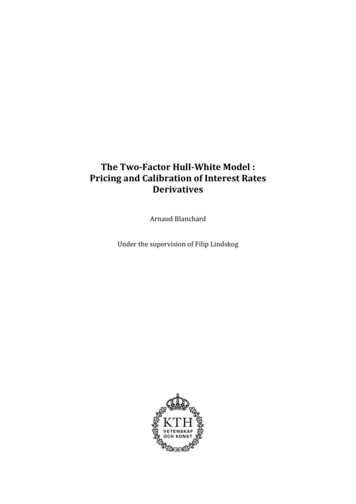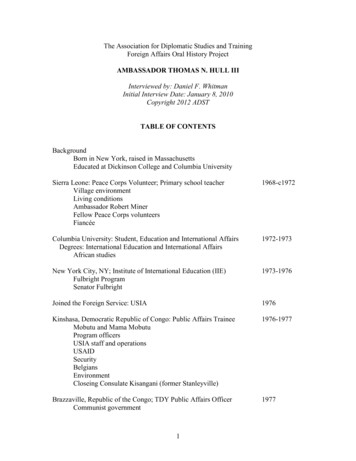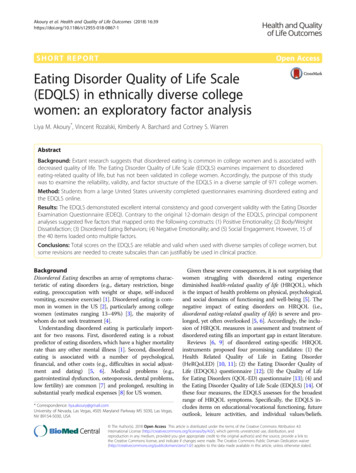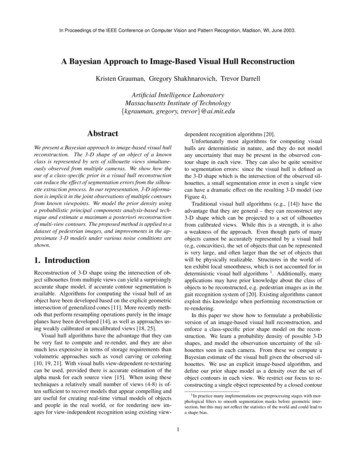
Transcription
The Two-Factor Hull-White Model :Pricing and Calibration of Interest RatesDerivativesArnaud BlanchardUnder the supervision of Filip Lindskog
2
AbstractIn this paper, we study interest rate models and theiraccuracy in the pricing of common structured products. Wespecifically focus on the Hull-White model, which was firstestablished in the article "Pricing interest-rate derivativesecurities" by John Hull and Alan White. Our goal is to studythis model, calibrate it on market prices, and derive pricesfor the most commonly traded products. In particular, weinvestigate whether it gives a satisfying description of realfinancial market prices.3
4
ContentsIntroductionI - Bonds, Rates, Interest Rates Derivatives 91 – The Zero-Coupon Bond . .92 – Rates definitions .93 – Interest rates derivatives .10a) Swaps . .10b) Caps, Floors . .12c) Swaptions . .124 – Structured Products . .14a) Callable Swaps .14b) Deposits . .15c) Extendable Swaps . .155 – Discounting and Credit Risk .15II – The Hull-White Short Rate Model . .171 – The One-Factor Hull White Model . .172 – The Two-Factor Hull White Model. .18a) The motivation for multiple factormodel . .19b) Definition . . .193 – Equivalence to the Two-Additive-Factor GaussianModel . .19III – Pricing Interest Rates products . .231 – Zero-Coupon Bond . .232 – Zero-Coupon Bond option . .253 – Cap, Floor . .284 – Swaption . .29IV – Calibration on Caps Prices and Volatilities . .331 – Purpose and Methodology .332 – Analysing the Results . .36a)Impactofthenumberofiterations . .36b) Fitting different markets : GBP, SEK,EUR . .39c) Time robustness and comparison to theOneFactorHullWhitemodel 42Conclusion .45Bibliography .475
6
IntroductionIn market finance, option traders need modelssimple enough to be understandable and usable, but alsorobust and accurate enough to fit market moves. The mostfamous and still in use model is the Black-Scholes model.This model is simple enough to be understood quite easily,and thanks to properties of the normal distribution and lognormal distributions it relies on, easily manageable. It takesinto consideration few parameters (strike and volatility).But this model is too simple to allow one set of parametersfor the whole market. In fact, each traded derivativeproduct need a set of parameters which is implied by thecurrent state of the market. Since there is a bijectionbetween the price of the option and the value of thevolatility, we can extract it from the state of the market (i.e.the prices of each product on the market), and by reversingthe Black-Scholes price formula, get the implied volatility,On interest rates markets, we can use models for interestrates to predict the evolution of our different underlyingrates. We particularly look for a model with fewparameters, which would replicate our underlying ratesand the volatility associated to specific options on themarket. Such a model would hence allow us to understandhow underlying interest rates interact with each other,based on fewer parameters than a simple Black-Scholesreverse of the market would offer.After an Overview and Definitions for the differentinterest rates and products we are going to study, we willexpose the Two-Factor Hull White model and looks at itsspecifics and properties. We will then use it to give theprices of the previously detailled product. Finally, we willfocus on one specific product and its market price, whichwill be used to calibrate and test the Two-Factor Hull Whitemodel.We suppose that the notions of arbitrage, stochasticcalculus and change of numeraire as defined is ArbitrageTheory in Continuous Time by Thomas Björk are alreadyknown to the reader.7
8
I - Bonds,DerivativesRates,InterestRatesI.1 – The Zero-Coupon BondA zero-coupon bond with maturity date , also called bond, is a contract which garantees the holder 1 to be paidon the date . The price at time t of a bond with maturitydate is denoted by , .We make different assumptions :- There exists a (frictionless) market for a -bonds forevery 0.- The relation , 1 holds for all .- For each fixed , the bond price , isdifferentiable with respect to the time of maturity .I.2 – Rates definitionsWe define different types of rates that we will usethroughout our study.1. The simple forward rate for , contracted at called the LIBOR forward rate, is defined as , , , , , 2. The simple spot rate for , contracted at calledthe LIBOR forward rate, is defined as , , 1 , 3. The instantaneous forward rate with maturity ,contracted at t, is defined by , log , 4. The instantaneous short rate at time is defined by , We have as a consequence of our definitions, for : , , !9 ,
A non-arbitrage argument implies also that , " # & ! %'ℱ )We define * to be the value of a bank account at time 0. We assume * 0 1 and that the bank accountevolves according to the following differential equation :,* * , , * 0 1where is a function of time. Hence we can write :* - % %& is known as the short rate. If we invest . at time 0, we&have on our our money-market account . - % % . Thebank account grows at each time at the rate .Our purpose is to model this short interest rate with amodel which can replicate the one we see on the market.We will look at other rates, financial products build onthese rates which are traded every day on financialmarkets. Based on their prices, we will calibrate our modeland see how well they fit the market.I.3 – Interest rates derivativesI.3.a – SwapsAn interest rate swap is a contract in which two partiesagree to exchange interest rate cash flows, based on aspecified notional amount from a fixed rate, known as theswap rate to a floating rate, typically a LIBOR rate (or viceversa). We denote the notional by /, and the swap rate by0. The LIBOR rate fixes on dates 1 , 2 , , 4 2 . If you swapa fixed rate for a floating rate (LIBOR), then at time 5 youwill receive/. 5 5 2 . 5 2 , 5 and you will pay the amount/. 5 5 2 . 0Hence the net cashflow 75 at time 5 is75 /. 5 5 2 . 5 2 , 5 0 10
We call this type of swap an arrear settled payer swap:you pay the fixed rate in exchange of the LIBOR rate, oneperiod after the fixing occurred.By definition of the LIBOR rate, we have:75 /. 5 5 2 . 875 /. ;1 5 2 , 5 1 5 2 , 5 09 5 5 2 . 5 2 , 5 1 0. 5 5 2 ?To compute the value of this specific cashflow at time , weneed to know the price of an asset at time t which value isequal to 75 at time 5 . Selling at time /. 1 0. 5 5 2 bonds delivering 1 at time T i would gives us a net cashflowof 1 0. 5 5 2 .We now need to find how to replicate A B@CDE,BC time 5 2 N worth of bonds delivering 1 at time 5 , which@@is to say A B ,B , we get A B ,B at time T i. The value attime of / is , 5 2 .CDECCDE. If we buy atCHence we have:F 75 , /. G , 5 2 , 5 1 0. 5 5 2 HAnd the price of a payer swap is hence equal to:IJKLI , 0, 1 , 4 4 / M G , 5 2 5N2 , 5 1 0. 5 5 2 HUsually, when two parties enter a swap, they agree to havea fixed rate 0 such that the price of the swap is equal tozero when the swap starts. Hence we have:0 45N2 , 5 2 , 5 45N2 5 5 2 , 5 0 , 1 , 4 5 2 , 5 45N2 511
We call 0 the swap rate.One of the main interests of swaps is to exchange floating,and then risky cashflows, against a fixed, and hence riskfree cashflows. For example, a company who wants tosecure a loan can use it. But it presents also somedisadvantages: if the floating rate is lower than the fixedrate, the company who pays (the fixed leg) loses money.Hence there is another way to hedge these floatingcashflow, without losing money when the fixed rate ishigher than the floating rate.I.3.b – Caps, FloorsFollowing our last example, there exist contracts that allowus to receive, when the fixed rate is higher than the floatingrate, the difference of these two rates multiplied by aspecific notional. Caps are contracts having thesespecifications.A cap with cap rate R and resettlement dates 1 , , 4 is acontract which at time 5 gives the holder of the cap theamount :2Q5Q4R5 5 5 2 max 5 2 , 5 0, 0We also define a floor, with cap rate R and resettlementdates 1 , , 4 , which is a contract which at time 5 thatgives the holder of the floor the amount :V5 5 5 2 max 5 2 , 5 0, 02Q5Q4When W 1 (i.e. there is only one payment), we use theterm caplet and floorlet. Caps and floors can then bereduced to streams of caplets and floorlets. When we willhave to compute the prices of caps and floors, we will onlyneed to know how to compute the prices of caplets andfloorlets.I.3.c – SwaptionsAnother famous interest rate derivative is the swaption.Such a product gives the right to its owner to enter in apayer swap (we call the it a payer swaption) or a receiverswap (receiver swaption). Let us note that a payer swaptionand a cap covering the same string of cashflows would have12
different prices. When we decide to exercise such aswaption (the swap rate on the market is higher than theswap rate – or strike - embedded in the swaption), we entera swap and have to exchange flows until the maturity of theswap, even if we sart loosing money when exchanging theflows. A caps only pays positive cashflows ; in fact we cansee it as the right to decide wether or not we exchangeflows on a payment date. Since there is more optionality ina cap than in a swaption covering the same period, the capwould be more expensive.We will focus on European Swaptions, which are swaptionswhich can be exercised one time only (there also existsAmerican Swaptions, which can be exercised anytime, andmore commonly Bermudan swaptions, which can beexercised periodicaly). Let us consider a payer swaptionwith strike X and exercise date , which allow us to enter apayer swap with fixing dates 1 , 2 , Y , , 4 2 ,cashflows occuring on 2 , Y , , 4 , swap rate X , andnotional /.At time the price of our swap would be Z[ , 0, 1 , 4 4 / M G , 5 2 5N2 , 5 1 X. 5 5 2 HAnd the swap rate 0 defined earlier would be0 1 , 4 5 2 , 5 45N2 5The swaption will obviously not be exercised if X is higherthan the swap rate 0 : it would be less expensive to enter aswap with a fixed rate equal to the swap rate. Hence we seethat we must have 0 X to exercise the swaption. Hencewe can write its payoff at time as4max ;/ M G , 5 2 , 5 1 X. 5 5 2 H , 0?5N2which can be rewritten as thanks to the definition of 0 :13
4/ max ;M G , 5 2 , 5 1 X. 5 5 2 H5N24 M G , 5 2 5N2 , 5 1 0 . 5 5 2 H , 0?and/ max\ 0 4 X M , 5 5 5 2 , 0]5N2I.4 – Structured ProductsWe gives here a rapid overview of the different structuredproducts banks market and sells to corporate clients. Theseproducts drives the prices and dynamics of the derivativemarket.I.4.a – Callable SwapsIf a corporate client wants to enter a payer swap, but wantsto pay a lower fixed rate than the swap rate on the market,a bank can offer him to buy another product from him, andthe cost of this product will be embedded into the fixedrate. From the customer point of view, the swap will have apositive value, which matches the price of the product hesold to the bank.Typically, a bank will accept to receive a lower fixed rate ifit gets some optionality over the trade. For instance, it canbuy from the corporate client a payer swaption, starting ina few years, with a strike equal to the fixed rate of the swapthey ae going to enter. The swaption is typically European,and most of the time Bermudan.This product gives the bank the right to enter the oppositeswap after a few years. Hence, it allows the bank to “call”the swap at exercise time(s), which is equivalent to cancelit.Hence a callable payer swap allows a customer to pay lessto have access to the floating rate (usually LIBOR). One ofthe downside is that he takes the risk to see the swapterminated sooner than a regular one.14
I.4.b – Deposits and LoansWhen a corporate client has an excess of treasury and won’tneed it until a certain period of time, it can make a simpledeposit to the bank. Then bank receives 1M to thecustomer and pays him the LIBOR rate plus a spread. Tomake the spread bigger, the client can still sell a product tothe client.In this case the product to be sold to the bank would be acap on LIBOR, which price would be embedded in thespread the bank add to LIBOR. The corporate client wouldhence receive bigger interests on his deposit, but if LIBORtends to be bigger than the cap’s strike, the bank would onlypay him interest based on the strike level and not LIBOR.The client can also buy a floor from the bank, which wouldmake the spread lower, but would protect him from to lowLIBOR rates.I.4.c – Extendable SwapsA corporate client could also need to enter a receivingswap. Imagine that a client wants to enter a 3 yearsreceiving swap, and also thinks that the rates will increasein 3 years. He could enter a 3 year swap with the bank andsell it a receiver swaption expiring in 3 years, offering thebank the opportunity to enter a payer swap at the samefixed rate than the one it enters today against the client. Tomatch the price of the swaption, the fixed rate received bythe client from the bank would be higher.If the client’s view of rates increasing in 3 years werecorrect, then the bank would not exercise the payerswaption., and he would have receive a higher rate than the3 year swap rate. In exchange, it offers the banks thepossibility to extend the swap for another two years if rateswould stay low. This kind of product might especially bepopular when rates are low, with a lot of uncertainty on thefuture, giving the options (which basically are insuranceagainst the future) more value.I.5 – Discounting and Credit RiskWe see that to discount cashflows with respect to time , wemultiply them by bond prices (which we also call discountfactors). This is due to the no-arbitrage assumption. Inreality, this is not true : markets do a distiction betwen therates on which the option is, and the rates which will be15
used to discount the cashflows. To make the the thesisreadible, we will consider that this is not the case here. Buthere are some reasons about the differences.The discount curve might vary with respect to products :for example, GBP european swaptions are discounted onSONIA (« Sterling OverNight Index Average »), but theinterests are paid on LIBOR (« London Interbank OfferedRate ») ; on the opposit, GBP bermudean swaptions keepsbeing discounting on LIBOR.The discount curve might also change as the clientchange :we can include the risk of credit in the discountingcurve, by adding a spread related to his default risk. Forexample, a top tier bank with good credit rating and a majorcompany with a high default risk would not pay the sameprice for a similar product. This is commonly taken into thediscounting method.Moreover, it is more and more common to use a collateralsto reduce the risk of default between two counterparties.Let us take another example. Bank A sells a swaptionexpiring in 10 years to Bank B. Bank A will receive 10,000,000 from bank B, and bank B will handle an optionwhich allows him to receive money from bank B in 10years. Let us suppose Bank A goes bankrupt : it won’t beable to honor the contract in 10 years. Hence the optiondoes not exist anymore and bank B has lost 10 millions. Toavoid these problems, bank A can post a collateral : It willmake a deposit in bank B of the previous 10 millions, andbank B will pay interest to A on these 10 millions. Hence, ifbank A defaults, the swaption dissapears, but bank B has itsmoney back. Bank A can also chose to post a collateral inEUR or in SEK instead of GBP, hence B will have to payinterests with respect to these currencies. The swaptionprice should be discounted at the rates corresponding tothe currency of the collateral ! That is why we see more andmore products based on a market but discounted withrespect to another market. The discounting model itself isnowadays complicated enough to be a complete subject ofanother thesis.16
II – The Hull-White Short Rate ModelsII.1 – The One-Factor Hull White ModelWe assume that our short rate follows the dynamics :, , ,Z with Z a Wiener process, and a deterministicfunction of time.This is a more general dynamics than the Vasicek model :, , ,Z with a positive constant. The solution of the equation ofthe previous SDE is a a a b a ,Z c 1 1 1The short rate has a normal distribution, with meanand variance " a 1 1 a d Y 1 Ya 2we see that when , we have" d Y2and the distribution of tends to h Ga , Ya H.i jkFrom the expression of " r t and Var r t , we see thatthe bigger the value of a, the « faster » r t tends to its limitdistribution. We call a the mean reversion : it defines howthe short rates dynamics tend to a limit mean.Negatives RatesSince the Hull-White model implies that the short rate has anormal distribution, this short rate could technically take17
every value of ℝ, and a fortiori negatives values. In fact, wecan even compute the probability of it relatively easily: 0 8pd q " 09 sq r" upd twith q a random variable such that q h 0,1 . Hence wehave: 0 w s r" upd tWhat would happen if the short rate were near 0? Whenrates on the market are very low, volatility tends to be alsovery low. In the One-Factor Hull-White model, this wouldbe equivalent to have a bigger mean reversion and asmaller \theta(t). From the expression of r(t), we see thatthe bigger the mean reversion, the lower the variance orr(t).Note: One would think that negative rates would beimpossible in real life ; however, we have seen recently thatbanks trading CHF (Swiss Franc) exchange a negativeovernight rate.II.2 - The Two-Factor Hull-White ModelII.2.a – The motivation for multiple factor modelsThe short rate and its distributional properties suffice tocharacterize the yield curve, as we have the relation :B , " xexp b , {and the fact that with all the bond prices, we canreconstruct the yield curve.However, a poor short rate model would lead to a poorrepresentation of the yield curve and its evolution. One-18
factor models such as the classic Hull-White gives 100%correlated LIBOR rates. We see that in reality this is not thecase, as we often see the yield curve steepening (short termLIBOR rates get lower, long term LIBOR rates get higher). Aone-factor model only allows us to parallel moves of theyield curve.II.2.b – DefinitionWe have seen that the One-Factor Hull-White model is amodel where the rates tends to reach a limit mean given by at a certain pace, given by the mean reversion . Thefunction is deterministic, but an intuitive way wouldbe to add it a stochastic component c , in fact to give itthe structure of the One-Factor Hull-White model, with amean reversion , lower than . Hence, after a certain time,our short rate model would tend to a one-factor stochasticfunction which would then itself tend to a deterministicfunction. We would then introduce a correlation factor }between the Wiener processes driving the dynamics of and c .This leads us to study the Two-Factor Hull-White model :, c , 2 ,Z2 ,c c , Y ,ZY with ,Z2 ,ZY }, .II.3 – Equivalence to the Two-Additive-Factor GaussianModelThe two factor Hull-White model is defined such that itassumes the short rate evolves in the risk-adjusted measureaccording to :, c , 2 ,q2 , 0 1,c c , Y ,qY , c 0 0with q2 , qY a two dimensional Brownian motion such that,q2 ,qY }̅ , , 1 , , , 2 , Y positive constants, and 1 }̅ 1. The deterministic function is chosen to fitthe current term structure of interest rates.We define the the new stochastic process c 19
where 2. a By differentiating , we get :, c , 2 ,q2 c , Y ,qY , G c c H , 2 ,q2 Y ,qY , , ,q with : 2 Y 2}̅ 2 ,q2 Y ,qY ,q Y 2 YYYMoreover, we define another new stochastic process : c The differentiation of gives us :c Y c , ,qY , , ,qY , with : Hence we can writewhere Y , , ,q , , ,qY 1 a b a , 1Hence we see that the Hull-White Two-Factor Model isequivalent to a « Two-Additive-Factor Gaussian Model ».This equivalence is going to be very useful to us. If it is moreeasy to interpret the different parameters of the Hull-White20
model and their influence on the price and volatilitystructures, the shape of the Gaussian model allows us toeasier calculations for the prices of bonds and derivatives.We have a perfect equivalence between the two models.If we write the HW2F as follow :, c , 2 ,q2 , 0 1,c c , Y ,qY , c 0 0such that is a deterministic function of time and,q2 ,qY }And the G2 as follow : . ,. . , ,Z2 , , ,ZY with a deterministic function of time such that 0 1, then we the coresponding equivalences betweeneach parameters of the two models : 2Y 2 Y 2}̅ Y 2 }̅ } YYY 1 a b a , 1or, put in the other way : 2 Y Y 2} Y } }̅ 2, , We will now proceed as follow : 1) We will calculate andcalibrate everything in the G2 framework, and then 2)21
analyze the equivalent parameters of the Two-Factor HullWhite model.22
III - Interest rates and product pricingsIII.1 – Zero-Coupon BondsWe denote by , the price at time of a zero-couponbond maturing at and with unit face value, so that , " # & ! %'ℱ )where " denotes the expectation under the risk-adjustedmeasure .We have seen that , % , is a gaussian process,hence it is entirely defined by its mean and variance.Bd , ℱ B d 8 b 1 a B ,Z2 c B b 1 B ,ZY c 9 Y B Y BYY Y b 1 a B ,c Y b 1 B ,cB b 1 a B 1 B ,c 2} 21 Ya B 3 Y Y a B 22 Y2 B 1 Y B 3 Y 2 2 a B 1 B 1 2} x a B 1{ and the mean" , ℱB " xb % , ℱ {B " xb . , ℱ {Because of the linearity and homogeneity of the expectationlinear application, and since is a linear process we canwrite :23
BB" , ℱ b " . ℱ , b " ℱ , B b , Hence by the definition of x, y and , the calculation ispretty straightforward, and gives :" , ℱ 1 a B 1 B . B b , We know that if q is a normal random variable with mean2 and variance Y , then " exp q exp G Y Y H . , is a normal random variable whose mean andvariance are now known. Hence2 D D& 2 D D& &a , 2 % % ¡ ,B YIn particular, we have 0, -2 % % ¡ 1,B YThis expression must fit the actual market, which meansthat for each we must have : 0, -2 % % ¡ 1,B YWhich leads us to -and for & % % % % 2 0, Y¡ 1,B & % % - % % & -& 0, 2 ¡ 1,B ¡ 1, Y 0, % % % %We can now rewrite the price of the zero coupon bond,fitting the current market, with our Hull-White parameters :24
, 0, 2 D a 0, D& 2 D D& 2 ¡ 1,B ¡ ,B ¡ 1, YWe introduce two new functions to shorten our nextequations : 0, 2 ¡ 1,B ¡ ,B ¡ 1, Y 0, 1 B * , , [ , Which gives us , [ , a, ,B , ,B ln , is linear in . and , which is the beauty ofthe Two-Additive-Factor Gaussian Model. This will be veryhelpful in both derivating the price of other products andnumerical implementation.III.2 – Zero-Coupon Bond OptionsThe price at time t of a European call option with maturity Tand strike K , written on a zero-coupon bond with unit facevalue and maturity isq*§ , , , X " # & % % , X ℱ )Under the T-forward (risk-adjusted) measure,processes . and follow the dynamics : Y 1 a B } 1 B { , ,Z2B Y, x 1 B } 1 a B { , ,ZYB ,. x . and with ,Z2B ,ZYB }, .The solution of these equations are for :25the
. . a % B , b a ,Z2 c % % B , b ,ZY c %with B , 8 Y } 9 1 a % Y Y Y a B a B Y% 2} B B a a % We get B , simply by replacing by , by , by and by in the expression of B , , thanks to thesimmetry of . and .Under the B measure, ℱ has a normal distribution,entirely defined by its mean and variance :" ℱ . a % % B , B , Y Y Ya % Y 1 Y % d ℱ Y 1 22 a % 1 2 The change of numeraire implies thatq*§ , , , X , " , X ℱWe know from previous calculations that , 0, 2 D ªDa 0, 2 D ªD 2 B B ¡ 1,« ¡ B,« ¡ 1,« Y We know that ln , conditional to ℱ is normallydistributed with mean26
0, 1 A ln d 0, d , d 0, 0, 21 a « B " . ℱ1 « B " ℱ and variancedAY YY 1 a « B 1 Ya B 2 YY 1 « B 1 Y B 2 1 a « B 1 2} « B 1 a B Using the formula 2 of the appendix, we get : , , , X 2 k , x Y¡ w 8 Xw A ln X {dA A ln X dAY9dASince A ,B is a martingale under B , we haveA ,« 2 k , " , ℱ Y¡ , which leads us to the identity A ln , 1 Y d , 2 Aand we can rewrite our price as , , , X , w ² , ln X , , Xw ²27dA1 dA ³2 , ln X , dA1 dA ³2
III.3 – Caps and FloorsWe have seen that a cap/floor is a thread of simple optionson LIBOR forward rates known as caplets and floorlets.We show that a caplet (or a floorlet) is actually equivalentto a put (or a call) option on a bond. The price of a caplet atime 0, with notional N and strike K which fixes at time 2and pays at time Y is given by : µ , 2 , Y , /, R " # &k %!/ Y 2 2 , Y R 'ℱ )where 2 , Y is the LIBOR rate, defined by : , 1 , , We can thus rewrite the caplet price as : µ , 2 , Y , /, R k" x & ! % / Y µ , 2 , Y , /, R 1 2 , Y 2 8 R9 ¶ℱ { Y 2 2 , Y 1 2 , Y 2 , Y ; R Y 2 ? ℱ ¹ /" · 2 , Y µ , 2 , Y , /, R & E ! % /" &E %! µ , 2 , Y , /, R /′" # &with G1 1 R Y 2 2 , Y H ºℱ E %! X 2 , Y 'ℱ )/ ¼ / 1 R Y 2 1X 1 R Y 2 We notice that the structure of the price of a caplet isidentical to a bond put’s with strike K and notional N’. Bythe same reasonning, we can show that a floorlet isequivalent to a call on a bond. If we know the arbitrage freeprice of an european option on a bond, we will deduce fromit the prices of caplets/floorlets, and by extension, the priceof caps/floors.28
III.4 – SwaptionsThe arbitrage free price at time 0 of a european arrearsettled payer swaption is given by numerically computingthe following one-dimensional integral :IJK½I¾ 0, , ¿, /, R, À /À 0, b 2 Á k GHY j 2Ä4·w Àℎ2 . M Æ5 . ÇC w ÀℎY . ¹ ,.5N2where À 1 (À 1) for a payer (receiver) swaption,ℎ2 . È Y 1 } } . È Y 1 } YℎY . ℎ2 . * , , 5 p1 } Æ5 . 75 [ , 5 a,B, C 1Y Y É5 . * , , 5 xÈ 1 } * , , 5 2} . È { . is the unique solution of the following equation4M 75 [ , 5 a,B, C ,B, C 15N2andÈ B 0, È B 0, 1 YaB21 Y B 2 } 1 a B } We derive this expression by taking the arbitrage free priceof the european swaption:29
Ê 0, , ¿, /, R, À 4 / 0, "B Ë·À ;1 M 75 , 5 ?¹ Ì / 0, b ·À ;15N2ℝk4 M 75 [ , 5 a,B, C ,B, C ?¹ ., , ,.5N2where f is the random vector . , , i.e., ., exp ; . È È È Y. È Y18GH 2} 9? Y 2 1 } Y2Ä 1
and see how well they fit the market. I.3 - Interest rates derivatives I.3.a - Swaps An interest rate swap is a contract in which two parties agree to exchange interest rate cash flows, based on a specified notional amount from a fixed rate, known as the swap rate to a floating rate, typically a LIBOR rate (or vice versa).











